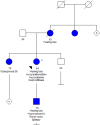Barakat syndrome diagnosed decades after initial presentation
- PMID: 38116790
- PMCID: PMC10762579
- DOI: 10.1530/EDM-23-0018
Barakat syndrome diagnosed decades after initial presentation
Abstract
Summary: Barakat syndrome, also called HDR syndrome, is a rare genetic disorder encompassing hypoparathyroidism (H), sensorineural deafness (D) and renal disease (R). A 64-year-old woman was referred to our endocrinology clinic for a switch in treatment (from dihydrotachysterol to calcitriol). She had progressive sensorineural deafness since the age of 18 and idiopathic hypoparathyroidism diagnosed at age of 36. Her medical history included osteoporosis with hip/spine fractures, nephrolithiasis and a family history of hearing loss, osteoporosis and kidney disease. The patient's clinical presentation indicated Barakat syndrome. Genetic analysis found a GATA3:c.916C>T nonsense variant. Further tests such as audiometry, labs and renal imaging supported the diagnosis. Due to rarity and manifold symptoms, diagnosis can be challenging. Optional GATA3 testing was suggested in 2018, except in cases of isolated sensorineural deafness or renal disease with pertinent family history. In isolated 'H' cases without 'D' and 'R', GATA3 studies are not required, as no haploinsufficiency cases were reported. Given the rise in genetic disorders, physicians should consistently consider rare genetic disorders in patients with suggestive symptoms, even decades after onset. Although diagnosis might not always impact management directly, it aids patients in accepting their condition and has broader family implications.
Learning points: There is currently an important increase in genetic and clinical characterization of new orphan diseases and their causative agents. Unbiased re-evaluation for possible genetic disorders is necessary at every consultation. It is essential to recognize the differential diagnosis of idiopathic hypoparathyroidism. The patient's clinical presentation and family history can be important to establish the correct diagnosis. Physicians should not hesitate to search a patient's signs and symptoms online.
Conflict of interest statement
There is no conflict of interest that could be perceived as prejudicing the impartiality of the case study reported.
Figures




References
-
- Ali A, Christie PT, Grigorieva IV, Harding B, Van Esch H, Ahmed SF, Bitner-Glindzicz M, Blind E, Bloch C, Christin P, et al.Functional characterization of GATA3 mutations causing the hypoparathyroidism-deafness-renal (HDR) dysplasia syndrome: insight into mechanisms of DNA binding by the GATA3 transcription factor. Human Molecular Genetics 200716265–275. (10.1093/hmg/ddl454) - DOI - PubMed
-
- Richards S, Aziz N, Bale S, Bick D, Das S, Gastier-Foster J, Grody WW, Hegde M, Lyon E, Spector E, et al.Standards and guidelines for the interpretation of sequence variants: a joint consensus recommendation of the American College of Medical Genetics and Genomics and the Association for Molecular Pathology. Genetics in Medicine 201517405–424. (10.1038/gim.2015.30) - DOI - PMC - PubMed
LinkOut - more resources
Full Text Sources

